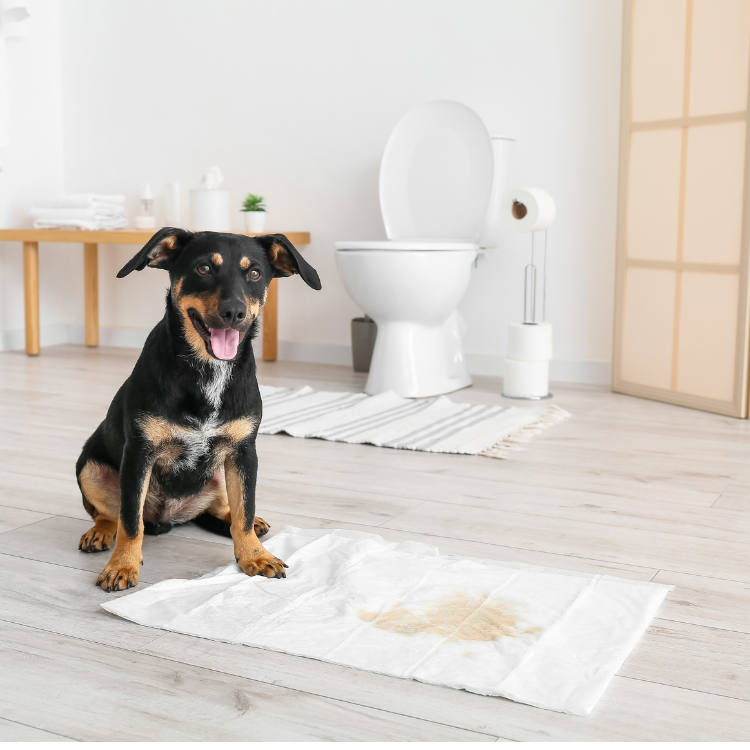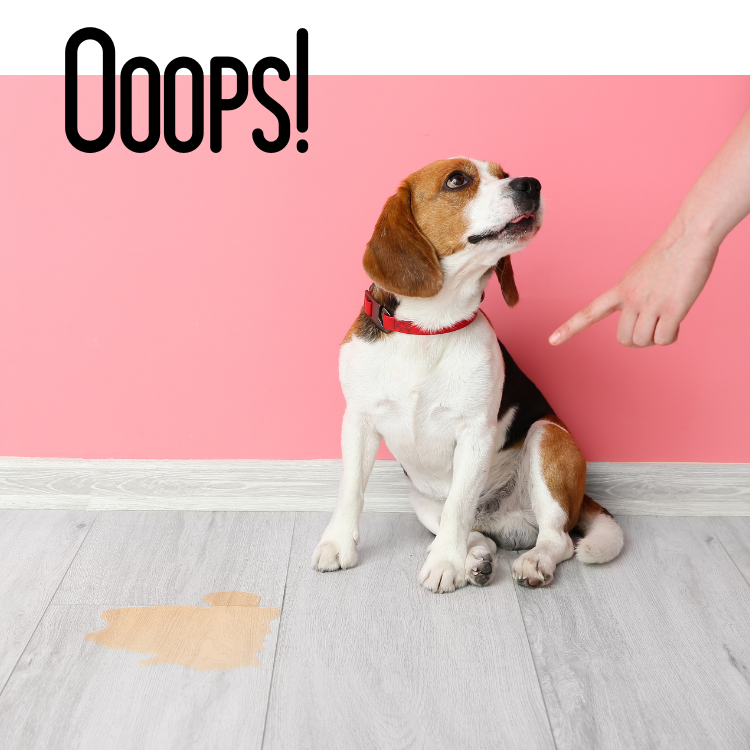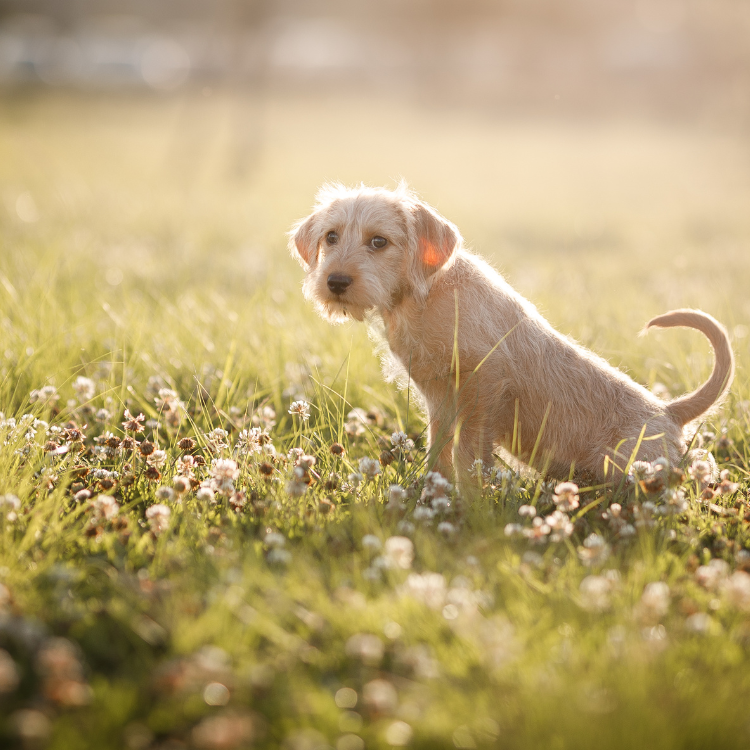In this post, we will talk about how to train your dog to use a pee pad and the things you need to know about doing it successfully. Have you welcomed a new puppy into your home? If you have, chances are they need to be potty trained. So, task number one is to train them to use a pee pad. If you train them as soon as you bring them into your home, this can be achieved relatively quickly.
With time and (lots) of patience, things can be achieved in about 2 – 3 weeks. But on average, it takes up to 4 months to train a dog to use a pee pad, especially if you have a very young puppy.
My advice to you is to get started on the potty training as soon as possible. As soon as your pet’s fluffy paws cross the threshold of your home, start the potty training so you can raise a good natured and sweet pup!
Keep an eye on your dog, especially if it is under or around 3 months old. Up to this age, a puppy may need to go potty every hour or so. This is where tons of patience comes into play!

Image: Canva Pro
Step-by-Step Guide to Training Your Dog to Use a Pee Pad
We have prepared a step-by-step guide on how to do this correctly, quickly, and with minimal stress (for more details on “How to Train Your Dog to Use a Pee Pad,” read this article https://pottybuddy.co/blogs/potty-buddy-blog/how-to-train-your-puppy-to-use-a-puppy-pad). Follow the science, stick to our advice, and your dog will quickly learn where he/she needs to potty.
Here are the steps in how to succeed in potty training your new little furry love!
Buy Plenty of Pee Pads!
Before your new pup comes home, make sure you’re all set by picking up some disposable pee pads. Tip: Grab them at the pharmacy where they’re usually cheaper than at pet stores. They are the same thing and stocking up will allow you to have them on hand when needed.
Don’t forget to snag some pet-friendly cleaning supplies to tackle any messes with ease because we all know accidents happen. This way, you will be well-prepared for all the fun (and a few oops moments) that come with your new four-legged friend!
At first, you’ll find your floor dotted with pee pads – it’s just part of the deal. Puppies have tiny bladders and aren’t picky about where they relieve themselves. So, during these early days, you’ll need to make peace with dedicating a good chunk of space for their “training bathroom.” It’s all part of the puppy parenting journey!
Have A Designated Spot
If you can, remove carpets and cover an area of the floor in a designated room, with absorbent pee pads. This is where you will bring your puppy every time it’s “time“.
If the dog goes potty in a different spot or in the wrong place show the dog that is not the right spot by carry it to the pee pad. Do it again – back to the pee pad. And so on every time.
Have A Potty Schedule Or Routine
It is also important to have a concise schedule or routine. Each day at the same time, take your dog to the designated pee spot (or outside to a certain area of your yard, if that is how you are doing it).
That way your pup will learn to expect those pee times and recognize those potty spots, and hopefully start going potty there, every time you bring him/her to ‘their spot’.
It may seem like it takes forever to potty train your dog, but in the end, the pup will start remembering and soon will learn.
Praise for Success
Whenever your little one nails it by using the pee pad, shower them with praise by petting them and by handing out treats. Just be sure to do this as soon as your pup has finished going potty and don’t wait, so that the puppy knows that is why you are praising them.
This tried-and-true training technique works wonders. Your pup will soon catch on to what earns them rewards and will go the extra mile to make you happy. Don’t skip the treats — studies have proven that training combined with treats helps dogs learn self-control, even in the most exciting moments!
No Scolding!

Image: Canva Pro
We all makes mistakes and a pup making one is no different! It is important to avoid scolding your furry friend if him/her has a slip-up or doesn’t quite make it to the pee pad. No yelling, nose-rubbing in mishaps, or hitting — these actions only instill fear.
Your pup might start thinking, “I got into trouble for doing something natural, so I should hide it next time to keep my owner happy.” This can lead them to find more hidden spots for their accidents, which is not what we want. Our aim is to guide them to use the pee pad, not find alternative spots (like under the bed).
Also, if your puppy is between 1 to 2 months old, it will often miss the pee pad. That’s normal. Little puppies don’t want to upset their owner; they just can’t control themselves yet. The puppy might also miss. But, if it goes to the designated spot or missed the spot by an inch, don’t scold because that’s also a success.
Don’t Rush too Quickly To Clean Up
Experts advise not to immediately dispose of soiled pee pads. It’s recommended to leave them in place for a little bit so that the puppy can orient itself by the smell. This will help it quickly get used to the “spot” where it can “do its business.”
Reduce the “Useful” Area
Once your puppy gets the hang of what you’re asking for, you can slowly begin to reclaim your floor, removing one pee pad at a time and making the designated spot smaller and eventually towards the door outside.
The correct direction is towards the front door if you have a pet that is not of a tiny breed and you do not plan to have a permanent ‘litter box‘ inside your home, (similar to a cat’s).
Hopefully soon your new pup will know to go to your front or back door asking to go outside because it will have become accustomed to going potty outside.

Image: Canva Pro
If you have a tiny puppy or toy breed and you want it to relieve itself in a litter box in your home, then move the pee pad to where it will eventually stand. For example, to the bathroom by the toilet or in a utility room.
These simple methods of teaching a dog to use a pee pad will help train your pup to pee in a designated spot and eventually peeing outside.
I know it takes some time but if you are willing to adopt a pup then you know it isn’t easy training it and taking care of it. It is a big responsibility!
Do you own a dog? Did you puppy train them? How was the potty training for them? Did it go smoothly or was it a long process? Let me know if you have any dog potty training tips in the comments below. I would love to hear them!